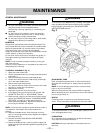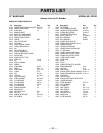
— — 18
1. Release both cam locking levers.
2. Slide the table extension on the side your workpiece
will be needing support, and tighten both cam locking
levers.
Slide the extension out until the correct measurement is
displayed on the tube scale. GENERAL CUTTING
Fig. T-1
WARNING
For your safety, read and understand all GENERAL and
SPECIFIC SAFETY INSTRUCTIONS on pages 4-6 before
using the band saw.
Operating band saws involves a certain amount of hazard.
Before attempting regular work, use scrap lumber to check
the settings and to get the feel of operating the band saw.
Read instructions and plan your work before cutting a
workpiece.
Do not turn the power ON until after you have made all
adjustments, checked that the guard is in place, and
turned the wheel by hand to make sure all parts work
properly. Always keep the guide assembly close to your
work, 1/8 "above the workpiece.
Do not force the workpiece, against the blade. Light
contact permits easier cutting and prevents unwanted
friction and heating of the blade.
Sharp saw blade need little pressure for cutting. Steadily
move the workpiece against the blade without forcing it.
To avoid twisting the blade, do not turn sharp comers,
saw around corners.
A band saw is basically a "curve-cutting " saw. It is not
capable of doing intricate inside cutting as can be done
with a scroll saw.
It is also used for straight line operations such as
crosscutting ripping , mitering, beveling, compound
cutting, and resawing.
WARNING
To avoid blade breakage, fire or other damage or injury,
NEVER use this band saw to cut ferrous metals.
CUTTING CURVES
When cutting curves, carefully turn the workpiece so the
blade follows without twisting, If the curve is so sharp that
you repeatedly back up and cut new kerf, use a narrower
blade, or a blade with more set (teeth further apart).
When a blade has more set, the workpiece turns easier
but the cut is rougher.
When changing a cut, do not withdraw the workpiece
from the blade. The blade may get drawn off the wheels.
To change a cut, turn the workpiece and saw out through
the scrap material area.
When cutting long curves, make relief cuts as you go
along.
CIRCLE CUTTING (Fig. U)
1. Adjust the guide assembly to 1/8" above the
workpiece.
2. Use both hands while feeding the work into the blade.
Hold the workpiece firmly against the table. Use
gentle pressure. Do not force the work, ALLOW the
blade to cut.
3. The smallest diameter circle that can be cut is
determined by the width of the blade. For example, a
1/4 " wide blade will cut a minimum diameter of
approximately 1-1/2 ".
Fig. U
1/8" 3/16" 1/4" 3/8"
1/2
"D
1 "D 1-1/2"D 2"D
1/2"
2-1/2"D
Blade Width
Circle Diameter
Minimum
BLADE SELECTION (FIG. V)
CAUTION: blade teeth are sharp. Use care when handling
a saw blade.
For longest wear and best cutting results, use the correct
blade thickness width, and temper for the type of material
you will cut.
When sawing small curves and delicate work, use narrow
blades. Otherwise, use the widest blade possible, For
cutting wood and similar materials with this bandsaw,
purchase blades in widths up to 1/2 ", and a length of 80 ".
Do not cut ferrous metals with this band saw.


















